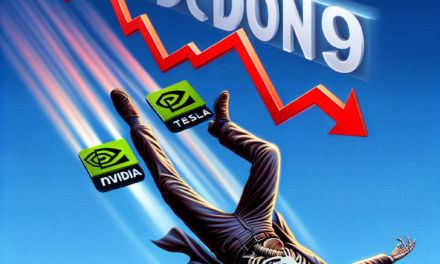“Tesla’s October Dip: Navigating the Competitive Waves of China’s EV Market”
Introduction
In October, Tesla experienced a 5.3% decline in its electric vehicle sales in China compared to the same month the previous year. This downturn comes amid intensifying competition in the world’s largest EV market, where both domestic and international automakers are vying for consumer attention with new models and competitive pricing. The decrease in sales highlights the challenges Tesla faces in maintaining its market share in China, a critical region for its global growth strategy. As local manufacturers continue to innovate and expand their offerings, Tesla’s performance in China remains a key indicator of its ability to adapt and thrive in a rapidly evolving automotive landscape.
Analysis Of Tesla’s October Sales Decline In China
In October, Tesla experienced a 5.3% year-on-year decline in electric vehicle (EV) sales in China, a development that has sparked considerable interest and analysis within the automotive industry. This decline, while seemingly modest, is significant given the competitive landscape of the Chinese EV market and Tesla’s previous growth trajectory in the region. To understand the implications of this sales drop, it is essential to consider several factors that may have contributed to this outcome.
Firstly, the Chinese EV market is becoming increasingly competitive, with domestic manufacturers such as BYD, NIO, and Xpeng rapidly expanding their market share. These companies have been aggressive in their strategies, offering a range of vehicles that cater to diverse consumer preferences and often at more competitive price points. Consequently, Tesla faces mounting pressure to differentiate its offerings and maintain its market position. The rise of these local competitors has undoubtedly played a role in the sales decline, as consumers now have more options to choose from, often with features tailored specifically to the Chinese market.
Moreover, the broader economic context cannot be overlooked. China’s economy has been experiencing fluctuations, with factors such as trade tensions, regulatory changes, and the lingering effects of the COVID-19 pandemic impacting consumer spending habits. In times of economic uncertainty, consumers may become more cautious with their expenditures, potentially delaying or reconsidering large purchases such as electric vehicles. This economic backdrop may have contributed to the observed decline in Tesla’s sales, as potential buyers weigh their options more carefully.
In addition to these external factors, Tesla’s internal strategies and challenges also warrant examination. The company has been navigating supply chain disruptions, a global issue that has affected many industries. These disruptions can lead to production delays and increased costs, which may impact the availability and pricing of Tesla vehicles in China. Furthermore, Tesla’s pricing strategy has been under scrutiny, with periodic adjustments that can influence consumer perceptions and purchasing decisions. Striking the right balance between competitive pricing and maintaining profit margins is a delicate task that Tesla must manage carefully.
Despite these challenges, it is important to recognize that Tesla remains a formidable player in the global EV market, including in China. The company’s brand strength, technological innovation, and commitment to sustainability continue to resonate with consumers. Tesla’s investments in local production facilities, such as the Gigafactory in Shanghai, underscore its long-term commitment to the Chinese market. These efforts are likely to yield positive results over time, as Tesla adapts to the evolving market dynamics and consumer preferences.
Looking ahead, Tesla’s ability to navigate these challenges will be crucial in determining its future success in China. The company may need to enhance its localization strategies, further tailoring its products and services to meet the specific needs of Chinese consumers. Additionally, continued investment in research and development could help Tesla maintain its technological edge and appeal to a broader audience.
In conclusion, while Tesla’s 5.3% year-on-year sales decline in China for October is noteworthy, it is not insurmountable. By addressing both external and internal challenges, Tesla can position itself for sustained growth in this vital market. The coming months will be critical in assessing how effectively Tesla can leverage its strengths and adapt to the competitive and economic landscape in China.
Factors Contributing To Tesla’s Year-On-Year Sales Drop
In October, Tesla experienced a 5.3% year-on-year decline in electric vehicle (EV) sales in China, a development that has sparked discussions about the various factors contributing to this downturn. Understanding the dynamics behind this decrease requires a comprehensive examination of both internal and external influences affecting Tesla’s performance in one of its most crucial markets.
To begin with, the competitive landscape in China has intensified significantly. Domestic manufacturers such as BYD, NIO, and Xpeng have been rapidly expanding their market share, offering a diverse range of EVs that cater to different consumer preferences and price points. These companies have not only improved the quality and technology of their vehicles but have also been aggressive in their pricing strategies, making it challenging for Tesla to maintain its dominance. Consequently, the increased competition has inevitably impacted Tesla’s sales figures.
Moreover, the Chinese government’s policies and incentives have played a pivotal role in shaping the EV market. While the government continues to support the transition to electric vehicles, there has been a gradual reduction in subsidies for EV purchases. This shift has affected consumer purchasing behavior, as potential buyers may delay their decisions in anticipation of more favorable conditions or opt for more affordable alternatives. Tesla, known for its premium pricing, may find it harder to attract cost-conscious consumers in this evolving policy environment.
In addition to these external factors, Tesla has faced some internal challenges that have contributed to the sales decline. Production and supply chain issues, exacerbated by the global semiconductor shortage, have led to delays in vehicle deliveries. These disruptions have not only affected Tesla’s ability to meet consumer demand promptly but have also impacted customer satisfaction and brand perception. As a result, potential buyers might be swayed towards competitors who can offer quicker delivery times.
Furthermore, Tesla’s strategic decisions regarding its product lineup and pricing in China have also influenced its sales performance. The company has made several price adjustments throughout the year, which, while intended to stimulate demand, may have created uncertainty among consumers. Frequent price changes can lead to hesitation among potential buyers, who might postpone their purchases in anticipation of further reductions. Additionally, Tesla’s focus on higher-end models may limit its appeal to a broader audience, particularly in a market where affordability is a significant consideration.
Another aspect to consider is the evolving consumer expectations and preferences in China. As the market matures, buyers are becoming more discerning, seeking vehicles that offer not only cutting-edge technology but also superior after-sales service and localized features. Tesla, while renowned for its innovation, faces the challenge of adapting its offerings to meet these localized demands effectively. Failure to do so could result in a loss of market share to competitors who are more attuned to the specific needs of Chinese consumers.
In conclusion, Tesla’s 5.3% year-on-year sales drop in China during October can be attributed to a confluence of factors, including heightened competition, changing government policies, internal production challenges, strategic pricing decisions, and evolving consumer preferences. As Tesla navigates these complexities, it will need to adopt a multifaceted approach that addresses both external market conditions and internal operational efficiencies to regain its momentum in this vital market. By doing so, Tesla can better position itself to capitalize on the growing demand for electric vehicles in China and sustain its long-term growth trajectory.
Impact Of China’s EV Market Dynamics On Tesla
In October, Tesla experienced a 5.3% year-on-year decline in its electric vehicle (EV) sales in China, a development that underscores the shifting dynamics within the Chinese EV market. This decline is not merely a reflection of Tesla’s performance but also indicative of broader trends and competitive pressures that are reshaping the landscape of the world’s largest EV market. Understanding these dynamics is crucial for comprehending the challenges and opportunities that Tesla faces in China.
To begin with, the Chinese EV market has been experiencing rapid growth, driven by government incentives, technological advancements, and increasing consumer awareness of environmental issues. However, this growth has also attracted a plethora of domestic and international competitors, all vying for a share of the lucrative market. Companies such as BYD, NIO, and Xpeng have emerged as formidable players, offering a range of vehicles that cater to diverse consumer preferences. This intensifying competition has inevitably put pressure on Tesla, which once enjoyed a more dominant position in the market.
Moreover, the Chinese government’s policies have played a significant role in shaping the EV market dynamics. While subsidies and incentives have historically fueled the growth of EV sales, recent policy shifts towards reducing these benefits have compelled automakers to adjust their strategies. Tesla, like other manufacturers, must navigate these changes while maintaining its competitive edge. Additionally, the government’s push for technological innovation and local production has encouraged domestic companies to enhance their capabilities, further intensifying competition for Tesla.
Another factor contributing to the decline in Tesla’s sales is the evolving consumer preferences in China. Chinese consumers are increasingly seeking vehicles that offer not only cutting-edge technology but also affordability and localized features. Domestic automakers have been quick to respond to these demands, often providing vehicles that are more attuned to local tastes and preferences. Tesla, while renowned for its technological prowess, faces the challenge of aligning its offerings with the specific needs of Chinese consumers.
Furthermore, supply chain disruptions and global economic uncertainties have also impacted Tesla’s operations in China. The COVID-19 pandemic, geopolitical tensions, and fluctuating raw material prices have all contributed to a complex operating environment. These factors have affected production schedules and delivery timelines, posing additional challenges for Tesla as it seeks to maintain its market position.
Despite these challenges, Tesla remains a significant player in the Chinese EV market, with its brand recognition and technological innovation serving as key strengths. The company’s commitment to expanding its manufacturing capabilities in China, as evidenced by the Gigafactory in Shanghai, underscores its long-term strategy to solidify its presence in the region. By increasing local production, Tesla aims to mitigate some of the supply chain challenges and better cater to the Chinese market.
In conclusion, the 5.3% decline in Tesla’s October sales in China highlights the complex interplay of factors influencing the EV market. While competition, policy changes, and consumer preferences present challenges, they also offer opportunities for Tesla to adapt and innovate. As the Chinese EV market continues to evolve, Tesla’s ability to navigate these dynamics will be crucial in determining its future success in this pivotal market. Through strategic adjustments and a focus on localizing its offerings, Tesla can continue to play a significant role in shaping the future of electric mobility in China.
Tesla’s Competitive Landscape In The Chinese EV Sector

In October, Tesla experienced a 5.3% year-on-year decline in its electric vehicle (EV) sales in China, a development that underscores the increasingly competitive landscape of the Chinese EV sector. This decline is not merely a reflection of Tesla’s performance but also indicative of the broader dynamics at play within the world’s largest automotive market. As the Chinese government continues to push for a transition to electric vehicles, domestic manufacturers have been quick to capitalize on this shift, intensifying competition for international players like Tesla.
Tesla’s entry into the Chinese market was initially met with enthusiasm, as the company was seen as a pioneer in the EV industry. However, the landscape has evolved rapidly, with local companies such as BYD, NIO, and Xpeng making significant strides in both technology and market penetration. These companies have leveraged their understanding of local consumer preferences and regulatory environments to offer products that are not only competitive in terms of price but also tailored to the specific needs of Chinese consumers. Consequently, Tesla now faces the challenge of maintaining its market share amidst a growing array of attractive alternatives.
Moreover, the Chinese government has implemented policies that favor domestic manufacturers, including subsidies and incentives that encourage the production and purchase of locally made electric vehicles. These measures have provided a significant boost to domestic companies, allowing them to invest in research and development and expand their production capacities. As a result, Chinese EV manufacturers have been able to offer vehicles with advanced features and competitive pricing, further intensifying the competition for Tesla.
In addition to the competitive pressures from domestic manufacturers, Tesla must also navigate the complexities of the Chinese regulatory environment. The Chinese government has imposed stringent regulations on foreign companies operating within its borders, including requirements for data storage and sharing, which have posed challenges for Tesla. Compliance with these regulations is crucial for maintaining a foothold in the market, yet it also adds an additional layer of complexity to Tesla’s operations in China.
Furthermore, consumer preferences in China are evolving, with an increasing emphasis on connectivity and smart features in vehicles. Chinese consumers are particularly interested in vehicles that offer seamless integration with their digital lives, a trend that domestic manufacturers have been quick to embrace. Companies like NIO and Xpeng have introduced models with advanced connectivity features, appealing to tech-savvy consumers and setting new benchmarks for the industry. Tesla, known for its innovation, must continue to adapt and innovate to meet these changing expectations.
Despite these challenges, Tesla remains a formidable player in the Chinese EV market. The company’s brand recognition and reputation for quality continue to attract a loyal customer base. Additionally, Tesla’s commitment to expanding its production capabilities in China, as evidenced by the construction of its Gigafactory in Shanghai, demonstrates its long-term commitment to the market. By increasing local production, Tesla aims to reduce costs and improve its competitive position.
In conclusion, Tesla’s 5.3% decline in October sales in China highlights the competitive pressures and challenges the company faces in this dynamic market. As domestic manufacturers continue to innovate and expand, Tesla must navigate regulatory complexities and evolving consumer preferences to maintain its position. While the road ahead is fraught with challenges, Tesla’s commitment to innovation and quality positions it well to compete in the ever-evolving Chinese EV sector.
Strategies For Tesla To Regain Market Share In China
In October, Tesla experienced a 5.3% year-on-year decline in electric vehicle (EV) sales in China, a market that has become increasingly competitive and crucial for the company’s global strategy. This downturn highlights the challenges Tesla faces in maintaining its market share amidst growing competition from both domestic and international automakers. To regain its footing in this vital market, Tesla must consider a multifaceted approach that addresses various aspects of its operations and market strategy.
Firstly, Tesla could benefit from enhancing its localization efforts in China. By increasing the production capacity of its Shanghai Gigafactory, Tesla can reduce costs associated with importing vehicles and parts, thereby offering more competitively priced models. Additionally, expanding its local supply chain network would not only lower production costs but also mitigate risks associated with global supply chain disruptions. This strategy would enable Tesla to offer more affordable vehicles to Chinese consumers, who are increasingly price-sensitive due to the wide array of options available in the market.
Moreover, Tesla should focus on strengthening its brand presence and customer engagement in China. While Tesla is already a well-known brand, increasing its investment in marketing and customer service could help solidify its reputation as a premium EV manufacturer. Hosting events, expanding test drive opportunities, and enhancing after-sales services are potential avenues to build stronger relationships with Chinese consumers. Furthermore, Tesla could leverage digital platforms and social media to engage with younger, tech-savvy customers who are more inclined to purchase EVs.
In addition to these efforts, Tesla must also prioritize innovation and technological advancements to differentiate itself from competitors. The Chinese market is rapidly evolving, with local companies like NIO, Xpeng, and BYD introducing innovative features and technologies. To stay ahead, Tesla should continue to invest in research and development, focusing on areas such as battery technology, autonomous driving capabilities, and vehicle connectivity. By offering cutting-edge technology, Tesla can maintain its image as a leader in the EV industry and attract tech-oriented consumers.
Another critical aspect for Tesla to consider is its alignment with China’s environmental and regulatory policies. The Chinese government has been actively promoting the adoption of new energy vehicles through subsidies and incentives. Tesla should ensure that its vehicles meet the latest regulatory standards and capitalize on government incentives to make its offerings more attractive. Collaborating with local authorities on sustainability initiatives could also enhance Tesla’s image as an environmentally responsible company, appealing to eco-conscious consumers.
Furthermore, Tesla could explore strategic partnerships and collaborations with local companies to enhance its market position. By partnering with Chinese technology firms, Tesla can integrate advanced software and services into its vehicles, offering a more comprehensive and localized user experience. Such collaborations could also facilitate Tesla’s entry into new market segments, such as ride-hailing or shared mobility services, which are gaining traction in urban areas.
In conclusion, while Tesla’s recent sales decline in China presents a challenge, it also offers an opportunity for the company to reassess and refine its strategies in this dynamic market. By focusing on localization, brand engagement, innovation, regulatory alignment, and strategic partnerships, Tesla can strengthen its market presence and regain its competitive edge. As the global leader in electric vehicles, Tesla’s ability to adapt and thrive in China will be crucial for its long-term success and growth in the international arena.
Consumer Preferences And Their Effect On Tesla’s Sales
In recent years, the electric vehicle (EV) market has experienced significant growth, with Tesla often at the forefront of this transformation. However, the latest data indicating a 5.3% year-on-year drop in Tesla’s October sales in China suggests a shift in consumer preferences that could have broader implications for the company. Understanding these changes is crucial for comprehending the dynamics of the EV market and Tesla’s position within it.
To begin with, the Chinese market is one of the most competitive and rapidly evolving in the world, particularly in the realm of electric vehicles. As the largest automotive market globally, China presents both immense opportunities and challenges for automakers. Tesla, having established a strong presence in China, has benefited from the country’s push towards sustainable transportation. Nevertheless, the recent decline in sales highlights a potential shift in consumer behavior that Tesla must address.
One factor contributing to this change is the increasing competition from domestic Chinese EV manufacturers. Companies such as BYD, NIO, and Xpeng have been gaining traction, offering a range of vehicles that cater to diverse consumer needs. These local manufacturers have not only improved the quality and performance of their vehicles but have also been able to offer them at competitive prices. Consequently, Chinese consumers now have a wider array of choices, which may be influencing their purchasing decisions and impacting Tesla’s sales.
Moreover, consumer preferences in China are evolving as buyers become more discerning and informed about their options. There is a growing demand for vehicles that offer advanced technology, superior range, and enhanced features at an affordable price. While Tesla has been a leader in innovation, the company faces the challenge of continuously adapting its offerings to meet these changing expectations. This requires a delicate balance between maintaining its brand’s premium image and ensuring its vehicles remain accessible to a broad audience.
In addition to competition and evolving consumer expectations, government policies and incentives also play a significant role in shaping the EV market in China. The Chinese government has been instrumental in promoting the adoption of electric vehicles through subsidies and favorable policies. However, as these incentives are gradually reduced or phased out, consumers may become more price-sensitive, further influencing their purchasing decisions. Tesla must navigate these policy changes while ensuring that its vehicles remain attractive to potential buyers.
Furthermore, the global supply chain disruptions and economic uncertainties have also impacted consumer behavior. The COVID-19 pandemic and geopolitical tensions have led to fluctuations in supply chains, affecting production and delivery timelines. These disruptions can influence consumer confidence and purchasing power, potentially contributing to the observed decline in Tesla’s sales.
In conclusion, the 5.3% drop in Tesla’s October sales in China underscores the complex interplay of factors influencing consumer preferences in the EV market. As competition intensifies and consumer expectations evolve, Tesla must remain agile and responsive to these changes. By understanding and addressing the needs of Chinese consumers, Tesla can continue to thrive in this dynamic market. The company’s ability to innovate, adapt to policy shifts, and manage supply chain challenges will be crucial in maintaining its competitive edge and ensuring sustained growth in the future.
Long-Term Implications Of Tesla’s Sales Trends In China
Tesla’s recent performance in the Chinese electric vehicle (EV) market has garnered significant attention, particularly with the revelation that its October sales have dropped by 5.3% year-on-year. This decline, while seemingly modest, raises important questions about the long-term implications for Tesla’s presence in China, a market that has been pivotal to its global strategy. Understanding these implications requires a closer examination of the factors contributing to this sales trend and the broader context of the Chinese EV market.
To begin with, it is essential to recognize that China is the world’s largest EV market, and Tesla has been a major player since it established its Gigafactory in Shanghai. This facility not only serves the local market but also acts as a crucial export hub for Tesla. However, the recent dip in sales suggests that Tesla is facing increased competition from domestic manufacturers. Companies like BYD, NIO, and Xpeng have been rapidly innovating and expanding their market share, offering a range of vehicles that cater to diverse consumer preferences. This intensifying competition is a significant factor that Tesla must navigate to maintain its foothold in China.
Moreover, the Chinese government’s policies and incentives play a critical role in shaping the EV landscape. While the government has been a strong proponent of electric vehicles, recent shifts in policy, such as the reduction of subsidies for EV purchases, could impact consumer behavior. Tesla, which positions itself as a premium brand, may find it challenging to compete on price alone, especially as local competitors offer more affordable alternatives. Consequently, Tesla’s ability to adapt to these policy changes and continue to appeal to Chinese consumers will be crucial for its long-term success.
In addition to external competition and policy changes, Tesla must also address internal challenges. The company has faced scrutiny over quality control issues and customer service in China, which could affect its reputation and consumer trust. Ensuring high standards and addressing customer concerns promptly will be vital for Tesla to maintain its brand image and customer loyalty in this competitive market.
Furthermore, Tesla’s strategy in China must consider the broader global context, particularly the ongoing trade tensions between the United States and China. These geopolitical factors could influence Tesla’s operations, supply chain logistics, and pricing strategies. Navigating these complexities requires a nuanced approach that balances global ambitions with local realities.
Despite these challenges, Tesla’s commitment to innovation and sustainability remains a strong asset. The company’s continuous advancements in battery technology, autonomous driving, and energy solutions position it well to capitalize on the growing demand for sustainable transportation. By leveraging these strengths, Tesla can differentiate itself from competitors and reinforce its leadership in the EV sector.
In conclusion, while the 5.3% drop in Tesla’s October sales in China may seem concerning, it is essential to view this trend within the broader context of the dynamic and rapidly evolving Chinese EV market. The long-term implications for Tesla will depend on its ability to adapt to local competition, navigate policy changes, address internal challenges, and leverage its innovative capabilities. As Tesla continues to refine its strategy, its performance in China will undoubtedly serve as a bellwether for its global ambitions and the future of the electric vehicle industry.
Q&A
1. **What was the percentage drop in Tesla’s China EV sales in October year-on-year?**
Tesla’s China EV sales dropped by 5.3% year-on-year in October.
2. **What could be a reason for the decline in Tesla’s China sales?**
Increased competition from local EV manufacturers and potential market saturation could be reasons for the decline.
3. **How does Tesla’s sales performance in China impact its global market strategy?**
A decline in China sales may prompt Tesla to adjust its global strategy, focusing on other markets or enhancing its offerings in China.
4. **What is the significance of China in Tesla’s overall sales?**
China is one of Tesla’s largest markets, contributing significantly to its global sales and revenue.
5. **How might Tesla respond to a drop in sales in China?**
Tesla might respond by introducing new models, adjusting pricing strategies, or increasing marketing efforts in China.
6. **What are some challenges Tesla faces in the Chinese market?**
Tesla faces challenges such as strong competition from local brands, regulatory changes, and fluctuating consumer demand.
7. **How does the drop in sales compare to Tesla’s performance in other regions?**
The drop in China sales may contrast with growth in other regions, highlighting regional market dynamics and challenges.
Conclusion
Tesla’s 5.3% year-on-year drop in October China EV sales could indicate increased competition in the Chinese electric vehicle market, potential shifts in consumer preferences, or challenges in maintaining growth momentum. This decline may prompt Tesla to reassess its strategies in China, focusing on enhancing its market presence, addressing local consumer needs, and possibly adjusting pricing or marketing tactics to regain sales traction.





